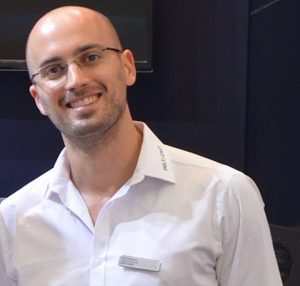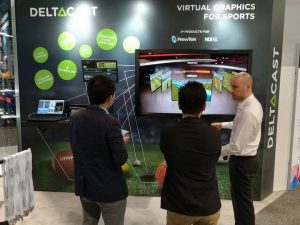SVG Europe Sit-Down: DELTACAST’s Erik Kampmann on virtual sports graphics and broadcaster relationships

DELTACAST International Sales Manager Erik Kampmann
DELTACAST’s products rely on a set of proprietary high-technology modules, including sensor-free tracking, image processing algorithms, adaptive chroma-keying, and a high-quality 3-D engine. The existing products are DELTA-live (live virtual graphics), DELTA-highlight (analysis tools), DELTA-touch (interactive presentation tool), Virtual View (realistic virtual 3D scene), DELTA-branding (advertising) and DELTA-stat (real-time on-air graphics). In addition, DELTACAST also performs specific projects for the professional TV broadcast market.
Our discussion with International Sales Manager Erik Kampmann began with a look ahead to future developments…
We are still in the early days of 2018. How do you see the business activities for DELTACAST progressing this year?
2018 is starting off great! 2017 was our best year so far, with major multi-year partnerships being renewed on top of new exciting projects that also spread over a long period of time. This allow us to start the year with great confidence, focus on the new challenges to come, with already some trips booked in India and Russia.
And, of course, talking about Russia, with the FIFA World Cup around the corner, we’re pretty thrilled on both the personal and professional levels! Big competitions always bring more visibility to DELTACAST, and thus more business. We are finalising a dedicated package for the competition that will include new features. In a nutshell, the package is a highly interactive presentation tool, very easy to set-up and handle, ingesting live stats, such as heat maps, team ranking and so on. It’s literary a plug and play server: you are ready to cover the World Cup within minutes, which makes it pretty handy to both TV rights and non-rights holders.
Visual graphics for sports broadcasting have expanded greatly in the last few years. What are the biggest challenges you face in coming up with new ideas?
Indeed, they have expanded greatly, so nowadays virtual graphics have become a standard in the industry and the ‘wow’ effect has disappeared. Today, one of the biggest challenges is to offer solutions that are always faster and easier to operate, so that more people on a production set can manage the creation of virtual graphics sequences. This is the main reason behind our automatic calibration feature that we released in the last version, which complements the automatic tracking available since several years. By offering even more automation, our clients save time and money, while still using our products to their full capacity.
Is it a case of sports producers coming to you with a requirement – or you approaching broadcasters with a solution they might need? How does that relationship work in practice?
Great question! All the products that make our success so far have mainly been ideas from our clients. Now you’ll ask, how did you start then? Well, as you know already DELTACAST is the sister company of DELTATEC, our high-level hardware and software design house which develops projects in many different industries such as medical, space, finance, and, of course broadcast, since 1988.
The first ever product that we created, DELTA-live – for offside lines mainly – was actually a request from a major sports broadcaster in Belgium back in 2004. It asked us if we could design an image-based processed offside lines that could be displayed within seconds. DELTACAST was born.
Our strength is that we can propose high technology to the market very quickly and efficiently. So our customers know that if they have some special requests, new features can be implemented in our solutions, which not only benefit them, but also brings added-value to our product line.
One major job is to always be proactive with our customers, travel around to see how production evolves as a whole, and bring back the information to our team to discuss the future. It’s not always easy to choose in what direction we will go, but that’s what makes this industry exciting.
Can you tell us more about your virtual branding solution and how it works in practical terms?
Sure. It’s image-based processed like all our product lines, plug and play, and very easy to handle. Once the system is calibrated, the end-user can display digital branding anywhere in the stadium. With our current R&D in AI, we are looking to bring new features in the future to this product, as digital branding now becomes an important segment of the market, especially as it brings additional revenues streams to broadcasters.
Everyone is seeking to reduce costs. How can this be achieved with regards to the broadcast graphics environment?
I think the short answer is automation. As explained earlier, the faster and easier our products are to operate, the more money and time will the end-user save.

DELTACAST’s stand at NAB 2017
Additionally, it also solves to some extent the problem of operators’ scarcity that our clients need to deal with. Usually, only a handful of operators will know the product like the back of their hand in the truck or in the studio and produce really nice sequences with lots of effects very quickly, but what happens when they are sick or unavailable? It costs time and money to find and train freelance operators, so by automating our solutions on top of a user-friendly GUI, less qualified people on a production set can start producing very high-end analysis clips very fast.
We are not completely there yet, but we’re working very hard toward that goal, with our R&D focusing a lot in AI and deep learning.
How has the increase in OTT impacted your solutions?
It’s very interesting to witness more and more OTT moving into sports. Honestly, it’s still pretty recent, and there is no direct impact for us yet. We are learning a lot through some of our clients that are heavily involved in providing services to OTT players. At this stage, we are working on integrating our solutions into new cloud-based workflow.
Have you an innovative European sports related case study you can share with us?
Well, we are proud to have started a great partnership with Skynet iMotion Activities (SiA), the production arm of Proximus TV in Belgium. They are a key player in Belgium in football production, and pioneers in remote production by starting a unique IP workflow last year with NEP, with several games being broadcast per day.
The project includes the complete suite of post-analysis virtual graphics of DELTACAST, mainly two DELTA-highlight complete systems, with their Virtual View and Bird View extensions, alongside DELTA-touch, to interactively drive the live studio shows for both the Belgian Jupiler Pro League and the EUFA Champions League.
The challenge for this project was that Proximus TV has to simultaneously produce two live productions for the French and Flemish speakers in the country, on top of a new IP remote workflow.
Both DELTACAST and Proximus TV benefit from this partnership, and it’s great to work with such innovators in IP!
